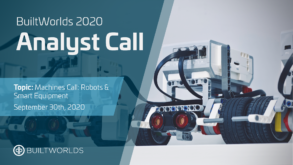
It is OSHA’s Nation Safety Stand Down in the United States this week, and to mark the occasion, we thought we would take a look at several areas where technology can help play a role in making our job sites safer, including:
- Digital twins and modeling software for better safety planning and training
- Wearables for hazard recognition and response
- Workflow management and insight offering apps
- Exoskeletons for reduced strains and wear
- Equipment Safety Features to reduce “struck by” incidents and more
We called our early look at safety technology in construction “Safe Insights,” and so we decided to look at the topic today through those early explorations as well as via more recent talks and presentations we have hosted and are continuing to host on this critical subject.
Fall Protection with Power Construction’s Use of Modeling and Triax Technologies’ Wearables.
In this two-part episode of our series, we visited with Ed Bowen, Site Superintendent for Power Construction, as he walked us through their steps, along with McHugh Construction, to ensure safety on the construction of a high rise building in downtown Chicago. From a technology perspective, at the end of the segment, they discussed the use of building modeling to plan for safety both in terms of where the placed safety-related items on the site and how they trained people working on the site about safety hazards.
We also visited with Chad Hollingsworth, then President of what has emerged as one of the leading, early players in the “wearables” market, Triax Technologies. As we have seen in more recent discussions, Triax has advanced significantly since we met with them back in 2017, but even then, we were intrigued by the potential of their product to help identify fall hazards on job sites and also to be more responsive to workers in need of assistance.
WakeCap Offers Another More Recent Look at Wearables in Construction Hard Hats
While Triax was early in the wearables space, we continue to see development there. More recently, WakeCap, a company that traces its roots to high volume, labor intensive construction activity in the Middle East, has made gains globally with its hard hat-based wearable. In this presentation, we can see some of the advances in technology in this category.
Hailing From Australia, Safesite Offered An Early Example of Automating Safety Management Workflows To Improve Efficiency and Administration and Also Gain Better Safety Insights and Culture.
Another really interesting early player in safety apps is Safesite. Founded in Australia in 2014, we first caught up with Safesite founder Peter Grant at our first Safety Meet-Up in January 2016. Safesite has grown significantly since our original meeting back in 2016, but here is a look back at what he was working on then. He offered case studies of early work with Ryan Construction in Arizona and Express Construction in Washington.
https://youtu.be/K9UuPLTaDEI
Larger Players Like PROCORE Have Also Begun Beefing Up Safety-Related Offerings
Earlier this year, we caught up with PROCORE to learn a little about what is on their roadmap for development in the coming year. We know that many of the major players in project management applications may have initially focused on workflows for rfi’s, submittals, change orders, and other more budget and schedule-related items. However, in this catch-up with PROCORE, we asked them about their initiatives in areas such as safety, quality, and accounting, and we found increasing focus in these key aspects of successful project management that “go beyond” what has traditionally been the focus of project management apps.
Ekso Bionics’ Exoskeletons Show Early Potential to Reduce Strains, Soft Tissue Injuries, and Wear and Tear on the Workforce.
In the video above from 2017, we took a look at one of the early prototypes of industry-focused exoskeletons. Through these investigations, we saw the potential of exoskeletons to reduce strains by making lifting easier and also to reduce wear and tear of high impact activities in the industry. More recently, an industry leader, Hilti, entered the exoskeleton market, and we are looking forward to seeing how this important area of the ecosystem develops in the coming years.
Join us September 30th to meet Hilti’s Eric Hollister as we talk about the current state of the construction exoskeleton market, including Hilti’s own entry into the space.

3D Robotics Gave Us An Early Sense of the Potential of Sensor Technology to Reduce Incidents of Workers and the Public Being Struck by Moving Construction Equipment
After two years of witnessing the growth of safety features in passenger cars and trucks on our visits to the ever-expanding automotive section of the annual Consumer Electronics Show, we set out to find examples of companies developing those equipment safety technologies for application in the construction industry. One of the early players we found was a company called 3D Robotics. They offered us one of the earlier examples of how connecting chips in wearables, equipment, materials, and other objects on a job site, we could help make our equipment smarter and reduce the odds of collisions.
More recently, at our Summit this past May, we talked with Chris Hummel of United Rentals about how they work with customers to help them improve job site safety and productivity. In the current environment, we also discussed Covid 19-related social distancing, contactless rental, self-maintenance, and other health and safety measures. (Jump to minutes 20 and 23 of Chris’ talk to hear more specifically about safety.)
As we continue to investigate, discuss, and learn about technology’s potential to improve safety on our job sites, we can see that bigger and more established industry players like PROCORE, Hilti, and United Rentals are truly beginning to embrace and more broadly aid the commercialization of safety enhancing technology in the industry, even while scrappy start ups like Triax, WakeCap, Safesite, and ekso continue to make strides within the industry. The result as a much more dynamics ecosystem of solutions for today’s construction project and site managers and safety professionals. There is a lot to understand and integrate in the safety topic, but the robust development of the sector over the past few years, gives us real reason to hope for step strides in reducing injuries and actually enhancing wellness on our job sites.
Not yet a member of BuiltWorlds? Click here to find out how you can join the network, be part of the conversations, share your expertise to help others in the industry learn, and also learn from others to help your own company stay at the forefront of emerging technology in the industry.






Discussion
Be the first to leave a comment.
You must be a member of the BuiltWorlds community to join the discussion.